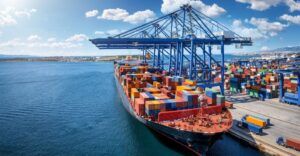Controlling borders is vital to every country’s national interest, from managing immigration to preventing drug smuggling, human trafficking, and terrorism. The seemingly simple answer of physical barriers such as fences and walls is generally ineffective, because they are expensive and susceptible to being breached or disabled. Cargo scanners are highly successful in detecting contraband at points of entry, but requirements for capital, training, and space currently limit the scope of their deployment.
The Surveillance Challenge
Technology advances are shifting the focus from geographical borders to digital virtual ones that draw on data sources from far beyond checkpoints and ports of entry. These approaches tend to scale easily over large distances and adapt to developing capabilities such as facial recognition and other biometrics, improved sensor technologies, and more cost-effective drones.
Open-ended integration of data sources such as financial records, location information, and lawful interception enhance both the breadth and depth of insights. Officials can use these measures to uncover the movements and activities of people and organizations of interest, as well as their wider context in international crime. This blog introduces high-tech border security with enforcement scenarios based on the global nature of drug trafficking organizations.
Interrupting the Flow of Fentanyl
Cartels and other large-scale traffickers demonstrate the futility of a myopic focus on regional border crossings to control the flow of drugs. While the vast majority of smuggling takes place at formal points of entry, any amount intercepted by authorities is simply accepted as a cost of doing business by the criminal organizations responsible. At the same time, many other shipments will make it through successfully.
Finding and disrupting those networks at the global level is a central strategy for law enforcement, as in the case of the complex fentanyl supply chain. Precursor chemicals that originate in Asia are shipped to large ports in Latin America, and from there they travel to small remote drug labs. The finished drugs are then smuggled into the market countries for distribution.
Throughout this motion, the activities of those involved leave digital footprints that can be assembled together with human intelligence and other sources to understand the criminal enterprise. Financial investigations follow the money through complex transactions, obfuscations, and shell corporations. Satellite pictures reveal activity at secret labs and airstrips, individuals of interest are monitored, and their communications are intercepted.
Those data sources are combined with others of every description. Investigators use lawful intelligence methods and tools to fuse disparate data together and create a composite picture of the criminal enterprise. This mechanism is well suited to collaboration among agencies, for data sharing as well as to extend information among local, national, and international law enforcement.
Shutting Down Drug Traffic at Sea
The Republic of Ireland has become a significant point of entry for drug cartels bringing cocaine into Europe. The complexity and international nature of enforcement are illustrated by the 2023 seizure of 2.25 tonnes of cocaine valued at over €157M—the largest in Irish history—from the cargo ship MV Matthew.
 The ship was purchased, renamed, and then resold to a suspected shell company in the Marshall Islands, all within a few months that summer; those transactions raised the attention of international law enforcement. Authorities from several countries monitoring the ship observed that it masked and misrepresented its location for approximately two weeks while in the Caribbean Sea.
The ship was purchased, renamed, and then resold to a suspected shell company in the Marshall Islands, all within a few months that summer; those transactions raised the attention of international law enforcement. Authorities from several countries monitoring the ship observed that it masked and misrepresented its location for approximately two weeks while in the Caribbean Sea.
Drug authorities knew the ship carried cocaine as it stopped in Guyana and then set off for Europe, eventually trying to meet up with the recently sold fishing trawler Castlemore in Irish waters. That meeting was thwarted by engine troubles onboard the Castlemore, inexpert seamanship that left it stranded on a sandbar, and a medical emergency onboard the Matthew. Ultimately, Irish Rangers boarded and seized the cargo ship.
Just as financial transactions and obfuscated location data were important clues early in the investigation, lawful intelligence provided additional insights as it progressed. Intercepted audio, including WhatsApp messages, revealed actions onboard, including plans to burn the cocaine to avoid capture. Keyhole Markup Language (KML) feeds of geographic tracking information from the vessels provided location and speed data, coupled with access to seized devices which held detailed information of the criminal activities.
The Emerging Future of High-Tech Border Security
The variety of data available to law enforcement will continue to grow, including from new types of sensors, drones, and many other sources. SS8 embraces that future with MetaHub data fusion and analysis capabilities built into the Intellego XT lawful intelligence platform. Looking ahead, machine learning and AI will play an increasing role in breaking down data siloes and providing analytics cost-effectively at massive scale. The future is getting ready to protect borders and public safety from drugs and the social disruption and violence that accompany them.
About Kevin McTiernan
 Kevin McTiernan is a seasoned professional with over 20 years of experience in the security industry. His extensive expertise spans big data, cybersecurity, network security analysis, and regulatory compliance. As Vice President of Government Solutions at SS8, Kevin specializes in the implementation of advanced intelligence solutions for the U.S. Government, law enforcement, and the Five Eyes alliance. He is an accomplished public speaker and an adamant supporter and volunteer for the National Child Protection Task Force. You can learn more about Kevin on his LinkedIn profile.
Kevin McTiernan is a seasoned professional with over 20 years of experience in the security industry. His extensive expertise spans big data, cybersecurity, network security analysis, and regulatory compliance. As Vice President of Government Solutions at SS8, Kevin specializes in the implementation of advanced intelligence solutions for the U.S. Government, law enforcement, and the Five Eyes alliance. He is an accomplished public speaker and an adamant supporter and volunteer for the National Child Protection Task Force. You can learn more about Kevin on his LinkedIn profile.
About Rory Quann
 Rory Quann is a Senior Solutions Engineer specializing in End-to-End Government Solutions at SS8 Networks and brings with him over 14 years of experience in the Lawful Interception and Data Analysis industry. Prior to joining SS8 in 2013, Rory worked for BAE System Applied Intelligence where he was focused on large scale Government deployments of Intelligence Solutions. Rory has held multiple positions in the Lawful Intelligence space ranging from Deployment Engineer, System Consultant, and Sales Engineer focusing on Country-wide Passive deployments. Rory is a Certified Microsoft MCSA Engineer and EMC Certified deployment Engineer. Learn more about Rory on his LinkedIn profile here.
Rory Quann is a Senior Solutions Engineer specializing in End-to-End Government Solutions at SS8 Networks and brings with him over 14 years of experience in the Lawful Interception and Data Analysis industry. Prior to joining SS8 in 2013, Rory worked for BAE System Applied Intelligence where he was focused on large scale Government deployments of Intelligence Solutions. Rory has held multiple positions in the Lawful Intelligence space ranging from Deployment Engineer, System Consultant, and Sales Engineer focusing on Country-wide Passive deployments. Rory is a Certified Microsoft MCSA Engineer and EMC Certified deployment Engineer. Learn more about Rory on his LinkedIn profile here.
About SS8 Networks
As a leader in Lawful and Location Intelligence, SS8 is committed to making societies safer. Our mission is to extract, analyze, and visualize critical intelligence, providing real-time insights that help save lives. With 25 years of expertise, SS8 is a trusted partner of the world’s largest government agencies and communication providers, consistently remaining at the forefront of innovation.
Intellego® XT monitoring and data analytics portfolio is optimized for Law Enforcement Agencies to capture, analyze, and visualize complex data sets for real-time investigative intelligence.
LocationWise delivers the highest audited network location accuracy worldwide, providing active and passive location intelligence for emergency services, law enforcement, and mobile network operators.
Xcipio® mediation platform meets the demands of lawful intercept in any network type and provides the ability to transcode (convert) between lawful intercept handover versions and standard families.
To learn more, contact us at info@SS8.com.

